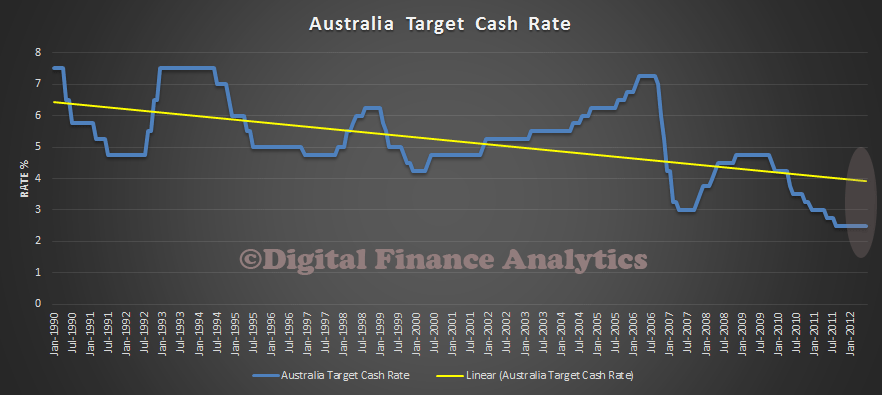The RBA published the notes from their last meeting today. The theme was similar to previous ones, “Members considered that the most prudent course was likely to be a period of stability in interest rates,” but in the variations, there was a sub-text relating to property prices. I have extracted just those paragraphs:
Members noted that Australian banks continued to report improving asset performance and strong profits, which had contributed to further increases in their capital ratios. Australian banks and non-banks had both benefited from easier wholesale funding conditions globally. This in turn had encouraged stronger competition in lending for housing and to large businesses, but members noted that this had not, to date, led to a general easing in mortgage lending standards and policies. For investors in housing, the pick-up in housing credit growth had been more pronounced than for owner-occupiers, with investor demand particularly strong in Sydney and, to a lesser extent, Melbourne.
Members further observed that additional speculative demand could amplify the property price cycle and increase the potential for property prices to fall later. The main risks in such a scenario would likely be to the stability of the macroeconomy rather than the financial system, particularly if households were to react to declines in their wealth by cutting back on their spending. Members were also updated on some of the recent actions by the Australian Prudential Regulation Authority in this area.
Members noted that commercial property markets in Australia had also been quite buoyant recently. Australian property had been yielding higher rental returns than were available overseas, which had attracted strong demand from both local and foreign investors. This had boosted prices even though rents for some types of commercial property had declined. In contrast, demand for finance from other parts of the business sector remained subdued, although business credit growth had picked up a little in recent months.
Members noted that the current setting of monetary policy was accommodative. Interest rates remained very low and had declined a little for borrowers since the cash rate was last changed. Investors continued to look for higher returns in response to low rates on safe instruments and were accepting more risk in doing so. Credit growth had picked up, including to businesses. Credit growth for investor housing was running at around 10 per cent per annum. Housing prices were continuing to increase in the larger cities and members considered that the risks associated with this trend warranted ongoing close observation. On the other hand, the exchange rate remained above most estimates of its fundamental value, particularly given the declines in key commodity prices and, overall, had offered less assistance to date than would normally be expected in achieving balanced growth in the economy.
I would tell the story rather different:
Banks have reduced the capital held against their growing pool of mortgage debt, so we hope the new advanced methods of capital calculation will support any risk of a down-turn. Still, the growth in investment lending at 10% is probably not an issue, after all, banks lending standards are just fine, no concerns apparently about the fact that half of new lending in the month was for investment purposes, nor the rise in interest only loans, or loans outside normal approval criteria. House prices continue to rise fast in (some of the cities) but we will just watch what happens, despite all the data showing prices are out of kilter with income, and other measures. Remember that interest rates are at rock bottom, well below the long term trend. They will correct at some point, and when the average mortgage rate is 7%, the chickens are likely to come home to roost. This is the key to potential falling prices later as with income growth below inflation, any lift in rates would have direct macroeconomic effects on borrowing households.

